Sports Tech@TDK
Unexpected Relation Between Blind Soccer and Self-Driving Cars, Perceiving Surroundings with Sound
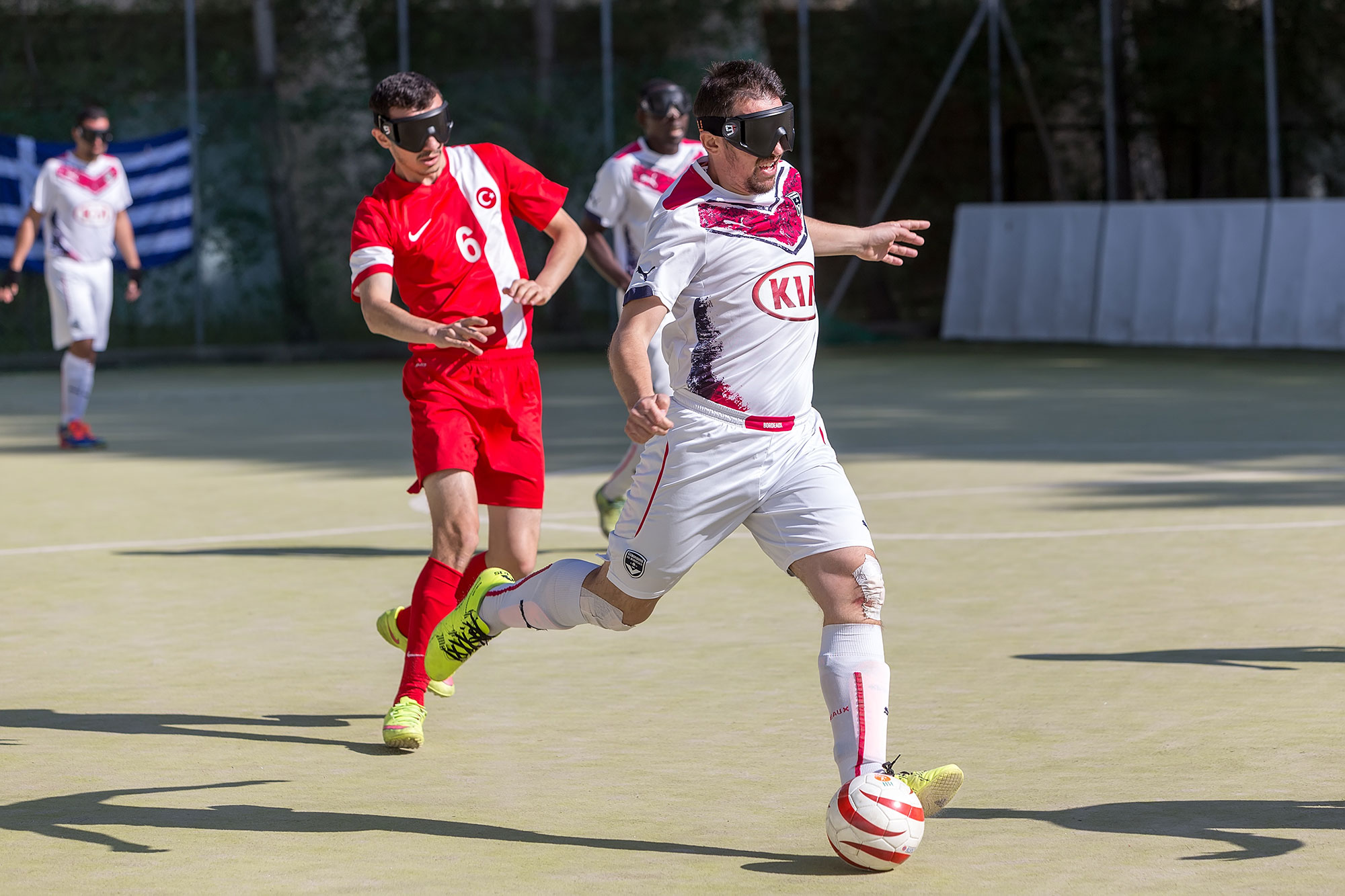
Blind soccer, played by players with visual impairments, is a five-man soccer game that relies on voice, sound, and faith in one's fellow players. Excluding the goalkeeper, all players are blind (though low vision and clear-sighted players are also accepted in Japanese domestic tournaments) ensured by the use of eye masks and play with a ball that makes noise. The Japanese men's team placed fifth at the Tokyo Paralympics in 2021 and finished second at the Blind Soccer World Grand Prix in France in 2022.
Relying on Sound localization to Determine Whereabouts of Opponents and Goal
In blind soccer, all field players except the goalkeeper are blind, ensured with the use of eye masks. The sight of these players dribbling and passing with totally obscured vision is dumbfounding. They pass the ball with pinpoint accuracy, dribble the ball while avoiding opponents and even shoot with considerable speed, surprising us all with plays that make it hard to believe that they are acting on voice and sound alone.
Spectators are not allowed to cheer during play, as players must rely on only their voices and sounds for play. The only time they are allowed to cheer is when a goal is scored. A loud cheer goes up from the audience to let the players know that a goal has been scored. In a blind soccer game, it may seem as if the players can see the ball and the movements of their opponents but for players who began playing blind soccer after having acquired visual impairments, they say they had a strong sense of fear when they first started playing.
Rei Kawamura, a member of Japan's national blind soccer team, said in an interview with the Japan Football Association, "When I first went out on the pitch, I didn't know where I was facing and was too scared to even run”. So, how do the players play?
The ball used in blind soccer has a metal plate attached to its interior, which makes a shuffling sound when it rolls. This sound allows the field players to determine where the ball is and how it is rolling. In addition, there are guides (callers) behind the opposing team's goal, who use their voices to inform the opponents and teammates of their position, the distance to the goal, and the timing of their shots.
When a field player moves towards an opponent who has the ball, they must always call out "Voy!” (which is Spanish for "I go") to prevent dangerous contact. Goalkeepers who are low vision or clear-sighted must then protect the goal without an eye mask while keeping an eye on the whereabouts of the ball.
Generally speaking, 80% of our information is obtained from sight. However, blind soccer, where vision is restricted, is a sport that requires the sharpening of senses to sounds and voices rather than sight.
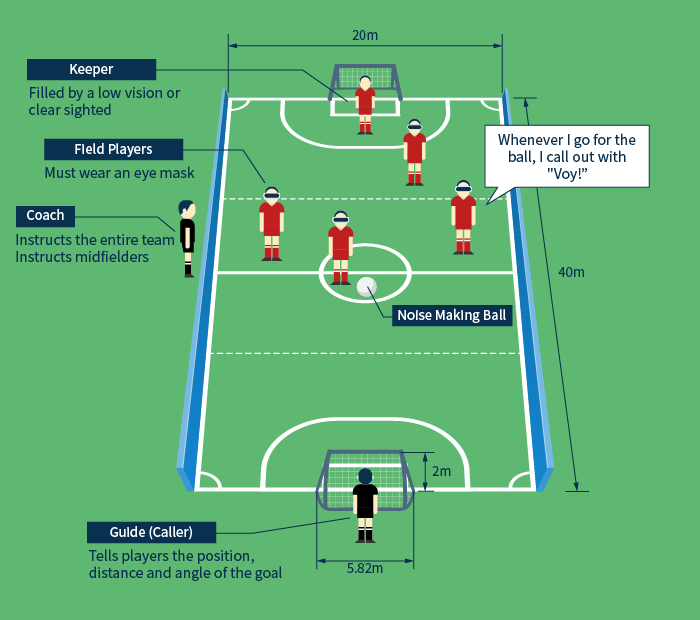
Blind soccer is played with four field players, a goalkeeper, a coach and a guide (caller) and lasts 20 minutes each half.
Technology uses sound to measure distance and direction
Blind soccer players determine the position of the ball and the direction of the goal by listening to the sound emitted by the ball and the voices of their teammates and guides. They can also judge the distance to the ball and their opponents through the volume of sound and voice. This technology of using sound to measure distance is also utilized in various electronic components. One such component is the ultrasonic sensor. Ultrasonic sensors use high-frequency sound, which is inaudible to humans, to measure distance. Ultrasonic sensors transmit ultrasonic waves from a transmitter, receive the sound waves reflected back by an obstacle, and calculate the distance by measuring the round-trip time.
For example, fish finders used by fishing boats to detect schools of fish transmit ultrasonic waves toward the seafloor and calculate the distance based on the time it takes for something to strike and return. Underwater, sound waves travel at a speed of about 1,500 meters per second, so if an ultrasonic wave is transmitted toward the seafloor and returns in one second, the depth of the water is found to be about 750 meters. If it returns in a shorter time than the seafloor, it can indicate the presence of a school of fish and its depth.
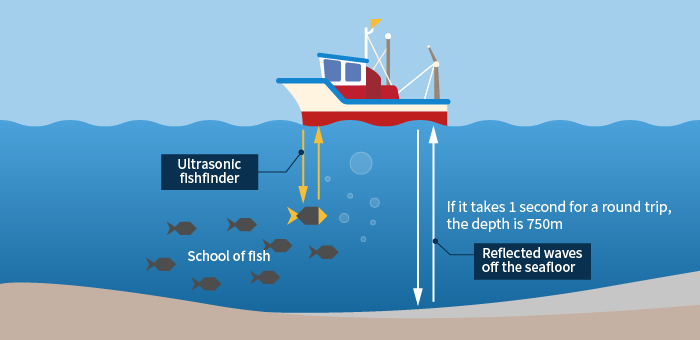
Ultrasonic Sensors Used in a Wide Range of Applications
Ultrasonic sensors are also called ToF (Time-of-Flight) sensors because they measure distance based on the time it takes for ultrasonic waves transmitted from the sensor to return.
Ultrasonic waves are sound waves in the frequency range above that which can be heard by the human ear (approximately 20-20,000 Hz). Hearing is more developed in animals than in humans, and it is not uncommon for animals such as bats, dogs, cats, and mice to possess ultrasound as an audible frequency. For example, the frequency of a dog whistle that can be used to signal a dog sounds at about 30,000 Hz, utilizing ultrasonic waves that are inaudible to humans but audible to canines. It is also said that moths have an ultrasonic audible range in order to detect and protect themselves from ultrasonic waves emitted by their natural enemies, bats.
Unlike optical sensors, ultrasonic sensors can accurately measure distances even when the target object is a transparent substance or liquid, or in conditions such as fog or direct sunlight. Today, it is widely used in self-driving cars, consumer electronics devices, drones, robots, and AR/VR devices.
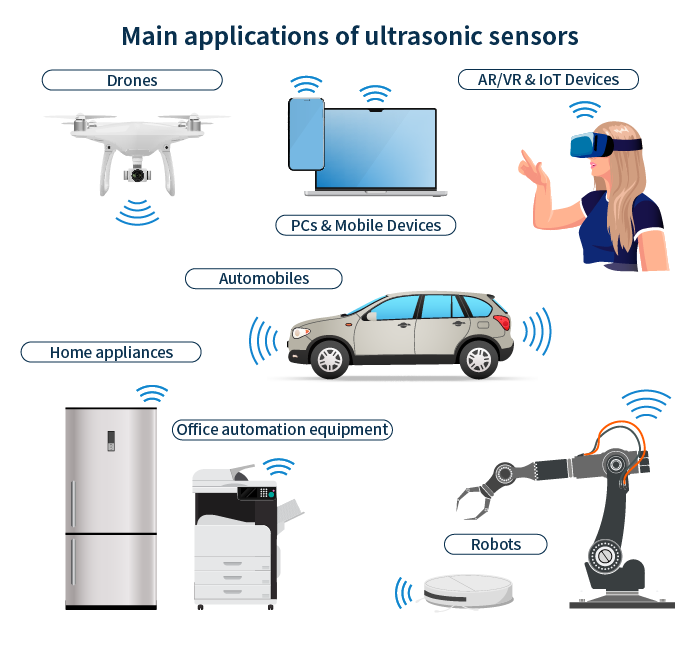
MEMS Ultrasonic Sensor for Miniaturization
Conventional ultrasonic sensors are assemblies of components called piezoelectric transducers that emit ultrasonic waves and cones that are used as resonators, which limits the miniaturization of products. This is why getting ultrasonic sensors into small devices such as wearable devices with miniaturization of the sensors has been a challenge.
TDK's ultrasonic sensors, however, are made using MEMS (micro-electro-mechanical systems) technology, an advanced processing technology, for the ultrasonic generation mechanism. This allows us to achieve an astonishing miniaturization of approximately 1/1,000 of the volume of conventional sensors. The device that generates ultrasonic waves and the ASIC that handles signal processing are packaged compactly in a small case measuring 3.5 x 3.5 x 1.25 mm.
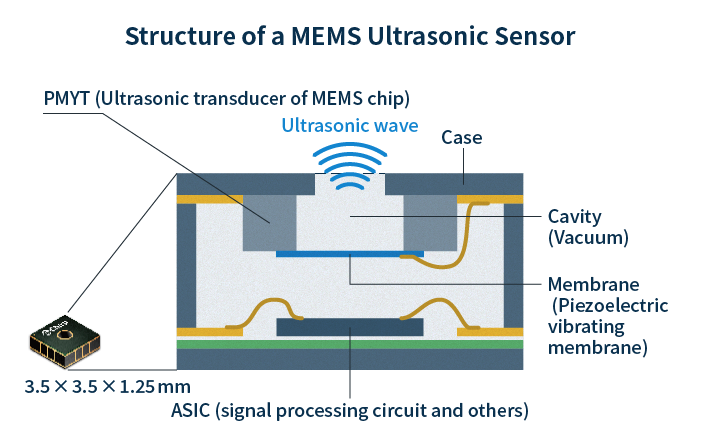
TDK’s ultrasonic sensors are innovative products that make full use of TDK's core product design technologies, including advanced MEMS technology, signal processing circuits with proprietary algorithm DSP (Digital Signal Processor), as well as compact module technology and packaging technology. Due to its features of low power consumption and ultra-small size, it is expected to be used in a variety of applications such as battery-driven IoT devices and other wearable devices. They are in active use in a wide range of fields that require high technical skills, just like those blind soccer players who judge their surroundings based on the direction of sound and the volume of their voices to make accurate plays without relying on their vision.
TDK's Ultrasonic ToF (Time-of-Flight) Sensor

TDK's SmartSonic™ ultrasonic ToF sensor is a high-performance distance measurement sensor module that integrates a PMUT (piezoelectric MEMS ultrasonic transducer) based on MEMS technology with an ultra-low power SoC (system-on-chip).
TDK is a comprehensive electronic components manufacturer leading the world in magnetic technology






